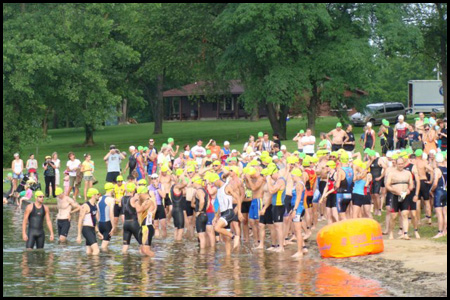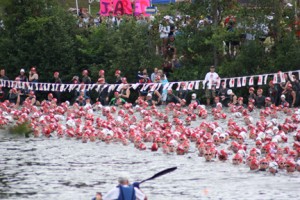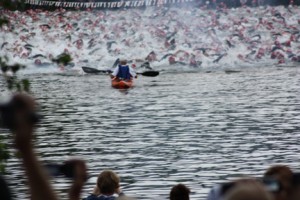

 There are very few things that spike the nerves as much as the mass start of a triathlon. It’s like water aerobics meets MMA cage fight, although in the water pretty much anything goes! I actually think I may have been fish hooked by someone’s big toe before. Anyways, the mass start pits overly caffeinated, anxious, sometimes overly self confident individuals against each other to see who can make it to the first turn buoy before anyone else. All in hopes to be able to open up one’s stroke and swim at a comfortable pace. Let’s face it, not everyone can be out front, nor is that the best scenario the majority of the time (as statistics would show). However, there are several things to consider when training and racing that will help you conquer the mass
There are very few things that spike the nerves as much as the mass start of a triathlon. It’s like water aerobics meets MMA cage fight, although in the water pretty much anything goes! I actually think I may have been fish hooked by someone’s big toe before. Anyways, the mass start pits overly caffeinated, anxious, sometimes overly self confident individuals against each other to see who can make it to the first turn buoy before anyone else. All in hopes to be able to open up one’s stroke and swim at a comfortable pace. Let’s face it, not everyone can be out front, nor is that the best scenario the majority of the time (as statistics would show). However, there are several things to consider when training and racing that will help you conquer the mass hysteria start and come out of the water feeling good and in one piece. Keep in mind this only pertains to the start of the race, on to the first few hundred meters. There is obviously more to consider in order to have a great swim leg.
1. Power in Numbers – The more people there are in the race, the less room there is for everyone to be on the inside line shooting the shortest distance to the turn buoy. If you are not one of the strongest swimmers in the field, you are better served to go a little to the outside, stay out of the melee, and swim the few extra meters around the course. Getting into the bunch usually causes newer swimmers to red line their heart rate which is never good at the beginning of the race or in the water for that matter. You will be much happier going into T1 if you have not spent the majority of the swim above threshold.
2. Know the Time Until the Gun Goes Off – Although it’s important to get in a warm up before a race, if you have to start in the water, it’s probably not the best idea to tread water for 10-15 minutes before the gun goes off. If you cannot get in the water before the swim start, use an active dynamic approach to your warm up on dry land. On another note, if you are one of those people with an over active bladder (or worse) on race morning, making sure you are on empty is important. But, the last thing you want to hear while sitting in a port-o-potty is the starting gun go off.
3. The V2H Rule – This is more geared towards the Ironman start. V2H stands for Vertical to Horizontal. It is just a reminder that when everyone is packed into a small space treading water they are all vertical. However, at some point everyone will default to going horizontal. If you are right in the middle of a bunch of people there is a good chance if you put your face in the water it will meet someone’s kicking foot. Again, if you are not the strongest swimmer, you will most likely save time in the long run by waiting back a little for the large group of racers to clear.
4. Know the Starting Conditions – All this means is that you should know what you are starting from and the implications of each:
 Beach Start – A beach start means there is a dash for the water when the gun goes off. Don’t red line yourself sprinting to the water and then try to high knee like “Prime Time” (I use this reference a lot to date the people I am working with). Once the water is above your knee you are better suited to start swimming or using the dolphin dive to progress forward. At the same time, if there are waves, make sure you dive under them rather than swimming through them. In order to avoid the current from an oncoming wave, you must dive under it and stay under it an average of double the time in seconds as it is tall. So a 3 foot wave would require you to stay under around 6 seconds to avoid getting pulled back to shore.
Beach Start – A beach start means there is a dash for the water when the gun goes off. Don’t red line yourself sprinting to the water and then try to high knee like “Prime Time” (I use this reference a lot to date the people I am working with). Once the water is above your knee you are better suited to start swimming or using the dolphin dive to progress forward. At the same time, if there are waves, make sure you dive under them rather than swimming through them. In order to avoid the current from an oncoming wave, you must dive under it and stay under it an average of double the time in seconds as it is tall. So a 3 foot wave would require you to stay under around 6 seconds to avoid getting pulled back to shore.
 Pontoon/Boat/Dock – This means you will have to dive into the water at the start. Many times, athletes will squeeze shoulder to shoulder on the edge, leaving little room for a good freestyle stroke when you enter the water. Dive deeper (if the water is deep) if you are a middle to back of the pack swimmer, and dive far if you are an upper middle to front of the pack swimmer. Lastly, make sure your goggles are on correctly. There is nothing worse than losing your goggles in the first second of the race.
Pontoon/Boat/Dock – This means you will have to dive into the water at the start. Many times, athletes will squeeze shoulder to shoulder on the edge, leaving little room for a good freestyle stroke when you enter the water. Dive deeper (if the water is deep) if you are a middle to back of the pack swimmer, and dive far if you are an upper middle to front of the pack swimmer. Lastly, make sure your goggles are on correctly. There is nothing worse than losing your goggles in the first second of the race.
 Treading Water – This has already been discussed a little above. If there is plenty of width to the course, you can even start wide to stay out of the insanity and swim a straight line to the turn buoy. If you are a strong swimmer, make sure you line up on the first row right under the starting line and shoot the inside line. Keep in mind that the fastest way anywhere is a straight line, but not when you are having to swim over the top of 2000 other people.
Treading Water – This has already been discussed a little above. If there is plenty of width to the course, you can even start wide to stay out of the insanity and swim a straight line to the turn buoy. If you are a strong swimmer, make sure you line up on the first row right under the starting line and shoot the inside line. Keep in mind that the fastest way anywhere is a straight line, but not when you are having to swim over the top of 2000 other people.
5. Goggles Under Cap – When putting your goggles on before the race, put your swim cap over the top of the straps. Some people also wear two caps with the goggles in between. This lessens the chance your goggles will get ripped, raked, or kicked off your face.
6. Race Specific Training – During your Peak (also known as Competition) phase of training, you should be spending the majority of your time focusing on race specific training. This means your workouts should mimic your race conditions as closely as possible. During your swim workouts, try and share a lane with a fellow triathlete or swimmer at all times. Find a training partner and go off on your intervals at the same time. Get use to making the choice to draft or lead the way. If you cannot find a training partner, pile all of the kick boards and pull buoys into the lane with you and work your way through them during your main set. Disclaimer: You should probably ask permission first, and clean up after yourself post workout.
7. Fast/Cruise Intervals – This is the most important training tip for surviving the mass start that I can give to triathletes of all levels. Why? Because it is the most sport specific swim workout one can do. You go out hard (like the start of the race), and then try to recover and settle into a steady pace. You can do 100 repeats all day long but you then you get a recovery period in which you are not moving. Even a 10 second rest is enough to let the muscles and cardiovascular system to recover. Try going hard for 100-200 yards and then cruising for 300-800 yards, focusing on recovering post hard effort and getting to a comfortable effort. Ideally, you want to be able to decrease the time of your 100 yard splits after the first 100-200 meters post hard effort. If you keep a training log, make sure you note your ability to recover from the hard to cruise interval.
8. Learn to Breath Bilaterally – I cannot stress enough on how important it is to be able to breath bilaterally. You never know what side another person will be flopping around on so it better serves you to be able to breath on either side. This does not mean you have to breath every 3rd stroke. It just means that you should have the ability to choose what side you want to breath on without getting a mouth full of water. Plus, breathing bilaterally keeps your muscles in balance and can prevent you from swimming in a zig zag pattern.
If you have any questions about these points, feel free to contact us. I know I will most likely think of some other considerations for surviving the mass start after this is posted.
~Dale


